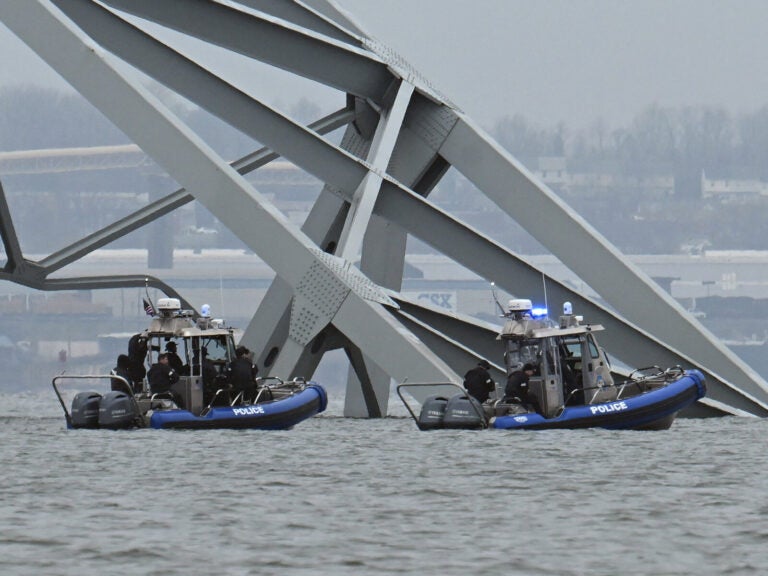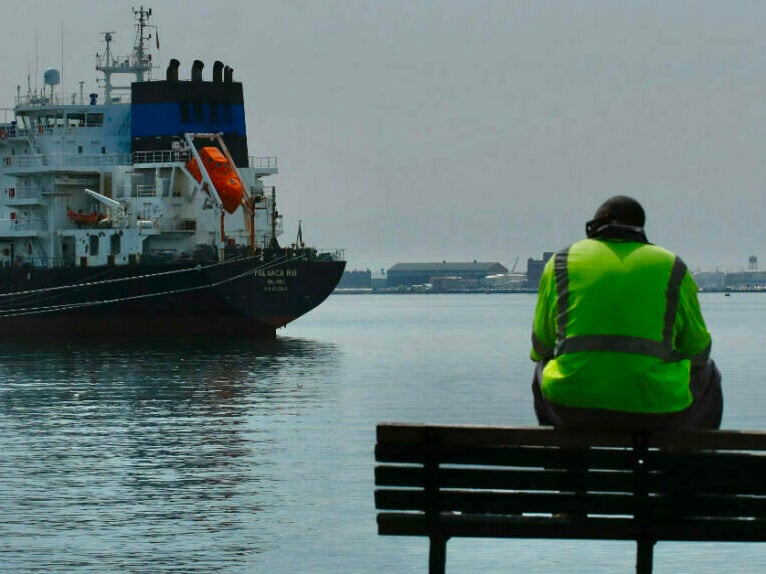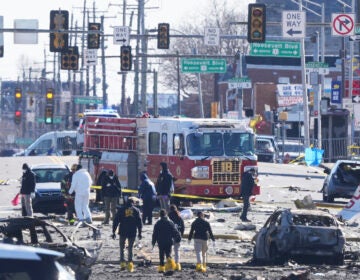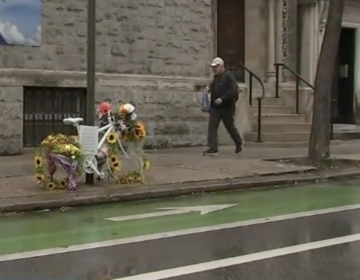‘We got workers in the water’: Audio reveals new details of Baltimore bridge rescue

Police recovery crews work near the collapsed Francis Scott Key Bridge after it was struck by the container ship Dali in Baltimore. Eight members of a construction crew repairing potholes were on the bridge when the structure fell into the Patapsco River at around 1:30 a.m. on Tuesday. (Jim Watson/AFP via Getty Images)
First responder efforts during the collapse of the Francis Scott Key Bridge in Baltimore on March 26 have been widely praised as well coordinated. Traffic was quickly diverted before the bridge tumbled into the water, avoiding greater loss of life. Still, eight construction workers fell into the water along with the bridge. Two were rescued, two were later found dead and the rest are presumed dead.
NPR’s Investigations Team analyzed more than 1,000 radio messages exchanged between first responders from the Maryland Transportation Authority Police, Baltimore City Fire Department and Baltimore City Police on the day of the collapse, downloaded from Broadcastify.com. The communications, most of which have not been published by any other outlet, reveal new details about the response from police and firefighters and highlight what those first responders did and did not know about the construction crew before and after the collapse.
When at 1:27 a.m., a pilot onboard the 949-foot container ship Dali issued a radio call saying the ship had lost power as it approached the Francis Scott Key Bridge, first responders jumped on the radio channels. Within the minute, Maryland Transportation Authority Police responded by telling officers to prevent cars from crossing.
“There’s a ship approaching that just lost their steering so until you got that under control, we have to stop all traffic,” he said.
The first responder then thought of the construction workers.
“Is there a crew working on the bridge right now?” the dispatcher asked. “You might want to notify whoever the foreman is, see if we can get them off the bridge temporarily.”
Seconds later the ship hit the bridge, which immediately buckled into the water. As it fell, another first responder called for backup so he could save the construction crew.
“Once you get here, I’ll go grab the workers on the Key Bridge and then stop the Outer Loop,” he said.
But by the time he made that call, at 1:29 a.m., the bridge was gone.
“The whole bridge just fell down, start, start, whoever, everybody,” another first responder confirmed into the radio. “The whole bridge just collapsed.”

First responders from multiple agencies including the Maryland Transportation Authority Police and Baltimore City Fire Department immediately began a rescue operation.
“All traffic going to Key Bridge is down,” said one. “We got workers in the water. See if we can get that Marine unit out here.”
Over the next 20 minutes, they tried to confirm how many of the construction workers were missing. The workers who fell in the water were from El Salvador, Guatemala, Honduras and Mexico. First responders had some difficulty communicating with the other members affiliated with the construction crew that were trying to help find their colleagues, the messages on the radio show.
“Probably the language barrier,” said one of the first responders, “but he’s saying there’s at least two more in the water.”
And then, just after 2 a.m., someone spotted something in the river.
“I’m up here with my light, uh, there’s a reflective vest in the water,” a first responder said. “I can’t tell if it’s a person or not.”
Fifteen minutes later, on the Baltimore City Fire Department radio channel, there were reports of someone receiving medical attention. Meanwhile, at least one diver was in the river, looking for the others.
“We’re investigating a construction truck [under] the bridge here searching for possible victims,” someone said on the Baltimore City Fire Department channel.
By early morning, the fire chief had announced that rescuers had pulled two people out of the river alive. The rescue and recovery efforts continued until the following day, when authorities said they’d found the bodies of two workers and could not keep looking for the other missing four because of dangerous conditions near the bridge. The names of the six workers who are dead or presumed dead are Dorlian Castillo Cabrera, Alejandro Hernandez Fuentes, Maynor Yassir Suazo Sandoval, Jose Mynor Lopez, Miguel Luna and Carlos, whose last name has not yet been released.
Ryan Dilkey, a search and rescue instructor at Eckerd College in Florida, pointed out that communication systems used to make distress calls are not optimized for alerting construction crews – since they don’t have access to the same radio as the ship pilots.
“Can I see a day where the next road crew will have a VHF marine radio somewhere on the truck? Or at least a handheld on somebody’s belt,” he said. “That if a mayday call was made by the next ship coming under the bridge, they’d hear it?”
But he praised the fact that authorities prevented motorists from entering the bridge.
“The efforts made to minimize road traffic, and we’re talking single digits of loss of life,” Dilkey said. “It could have been a much larger number.”
9(MDAzMzI1ODY3MDEyMzkzOTE3NjIxNDg3MQ001))




